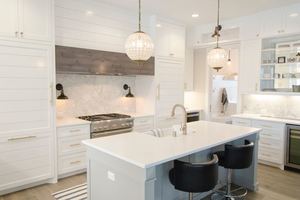Your Guide - Loft Conversions
Share
Copy Link
A loft conversion can be one of the easiest and least disruptive ways to add extra space to your home. So many families in the UK are choosing to convert their loft rather than move, particularly if they really like their current home and just need more space.
Although the cost of a loft conversion can vary significantly, broadly anywhere from £20,000 - £60,000, it is thought to be a better investment and often cheaper and less stressful than moving home.
Not only does this type of renovation have its benefits in terms of functionality, but it will also add a significant amount of value to your home, with a typical loft conversion adding around 11% to the value of your home.
If you are thinking about a loft conversion in the near future and need some help finding an architect or designer, we can match you with the most suitable ones for your project.
Find an architect or designer

What kind of loft conversions are there?
There are four main types of loft conversion in the UK:
Velux
This is the most basic conversion as the actual structure of the roof doesn’t change, and skylight windows (hence the term ‘Velux’) are installed into the pitch of the roof. If you have a sizeable loft space, a Velux conversion is an ideal way to add a new bedroom or study to your home.
Dormer
The Dormer is the most common type of conversion in the UK and is ideal for a semi-detached or terraced home in a built-up area. In a Dormer conversion, the roof is extended vertically to create more headspace and more usable floor space.
Mansard
This kind of conversion changes a sloping roof to be almost vertical by extending the walls up with a new timber structure. A Mansard conversion will offer more headspace, along with many of the advantages offered by a Dormer conversion.
Hip to Gable
This is when the sloping side of the roof is converted to a flat gable end to create more headspace. A Hip to Gable conversion is suitable for bungalows, semi-detached, and detached homes, and they are often combined with Dormer or Mansard conversions.
How much is the cost of a loft conversion?
The cost of a loft conversion cost can vary greatly depending on the type and size of the conversion, what it's being used for, and where you are located in the UK. Our cost estimator will give you a high level guide of the cost of your loft conversion and is a great place to start!
Do I need planning permission for my loft conversion?
We know the prospect of converting and designing your home can be daunting, especially with factors such as planning permission and building regulations to consider.
Many loft conversions don’t require planning permission as they are considered to be within the permitted development, however there are a number of exceptions to look out for, including:
- If you are converting your loft by more than 40 cubic metres in a terraced house and more than 50 cubic metres in a semi-detached or detached house
- If you are raising the roof above the highest part of the original roof or beyond the plane of the existing roof slope of the principle elevation when you are facing a highway
- If the material of the conversion is different to the existing property or if you are incorporating a balcony, veranda or terrace
- Particular kinds of homes such as flats or in a designated area like a conservation area
If you’re considering converting your loft space, you should always consult your local authority and confirm whether you are within the permitted development.
Do I need building regulations approval for my loft conversion?
Even though you may not require planning permission, you always need to ensure that your conversion is fully compliant with building regulations. This is to ensure your conversion meets health and safety requirements.
Building regulations checks will include:
- The new structure
- The fire resistance
- The access and escape means
- The insulation and ventilation
Many architects and loft conversion companies work with a structural engineer and will submit the building regulation plans for you, but do confirm they are covering this off. The site will be inspected to confirm the conversion has passed. You should get a completion certificate 8 weeks after completion - do make sure you get this.
Your architect or loft conversion company will also guide you on whether your home falls within the Party Wall etc. Act 1996 (England and Wales only). If it does apply to your home, you will need agreement from your neighbours, so it’s worth taking them through your plans at an early stage. If you need to know more then read our expert advice - party wall act.
Read our article to find out more about loft conversion building regulations.
Who can help plan my loft conversion?
When it comes to your loft conversion, there are two main options to get started:
An architect or architectural technologist
A qualified architect (ARB) or architectural technologist (CIAT) are good options to kick off your project, particularly if you need to apply for planning permission.
An architect (ARB) is the best route if you need design inspiration on your loft conversion. However, if you have a clear brief then an architectural technologist is a great option. Architects (ARB) typically charge the highest rates, so only use one if you need their design skills, otherwise opt for an architectural technologist (CIAT).
Loft conversion specialists
Another option is to engage with a local loft conversion company who can manage everything from the design, structural calculations and the build.
A reputable loft conversion specialist will take away the hassle and offer a single point of contact throughout the process. They are also experienced in loft conversions and will be able to provide solutions to any issues that crop up as well as navigate the planning process (should you need it!).
The downside to a loft conversion company is that you are likely to pay a premium as they offer an end to end service. Additionally, the builders can be outsourced and you may have less control over the quality of their workmanship.
Who else might be involved?
Here are the other specialists that are likely to be involved:
Structural Engineer
A structural engineer will be responsible for producing the structural drawings and calculations that are required for building regulations. Structural engineers are always involved in your loft conversion as you must adhere to building regulations.
If you have a clear brief and your project is within permitted development (i.e. you don’t need to apply for planning permission), then an experienced structural engineer may be the only contact you need apart from your builder.
Surveyor
If you are carrying a large renovation on a run down property it's worthwhile appointing a surveyor at the outset to identify any issues that you may otherwise overlook.
You will also need a surveyor if the Party Wall Act applies to your loft conversion, which is likely if you property is adjoining another but do check with your architect to get guidance.
Builder
Unless you are an expert yourself then you will need to appoint a builder. You can either choose a builder who can do everything and either employs specialists (such as plumbers and electricians) or you can employ individuals and project manage the process.
Be aware that project managing various tradesmen that haven’t previously worked together might be challenging.
How long will it take to complete my loft conversion?
A simple loft conversion should take around 4-6 weeks but do allow up to 8 weeks when a roof is being replaced. Patience is key as you will need to factor in the décor and interiors afterwards.
How do I know whether my home is suitable for a loft conversion?
The key things you need to check are:
Head Height
For a comfortable living space, you need at least 2.2 metres at the highest point, which is normally the centre. If you don’t have this you can raise the roof or lower the floor but it will be far more costly than an average loft conversion.
New staircase
You should ensure that there will be room to build the staircase and that there is at least 2 metres of headroom over the stairs, to comply with building regulations. This can be relaxed to 1.8 metres at the edge of the stairway to allow for a sloping roof but you must have 2 metres at the centre.
Think very carefully about how you will use the original floor space on the first floor as you do not want to take away too much of the existing living area. Make sure to discuss the stairs and the many options with your architect or designer at length.
Roof Pitch and Span
Although the pitch and span won’t impact whether you can have a loft conversion, they will have an impact on how spacious your loft conversion will feel and what you can do with the space.
A high pitch angle will mean a higher headspace which will allow more floor space for a Dormer or Mansard conversion. The wider the roof span, the more floor space will be available.
Type of Roof
Homes built before the 1960s have different frames and the space can be opened up easily with the rafter strengthened and adding support.
Homes built post 1960s tend to have no load bearing structure, therefore when you convert, you will need to add in supporting steel beams. This option will add to the time and cost of the project.
How do I insulate my new loft?
Good quality insulation will help keep the space feeling warm in the winter and cool in the summer. Make sure you invest in the best quality insulation your budget will allow.
To remain in line with building regulations, as a minimum you need a U-value (a U-value measures how effective the material is as an insulator and the lower the better) of no more than 0.16W per metre squared. You will need at least 270 mm of mineral wool or 130 mm of PUR insulation to achieve this. This must be installed at the rafters if the room is inhabited. More insulation will reduce the U-value further, which will also reduce energy costs and reduce CO2 emissions.
Anything else to consider?
Don’t forget about the lighting, storage and design. You want to make the most of your new conversion and maximise the space!
If you are thinking about a loft conversion in the near future and need some help finding an architect or designer, we can match you with the most suitable ones for your project.
Find an architect or designer
Published: October 7, 2020



